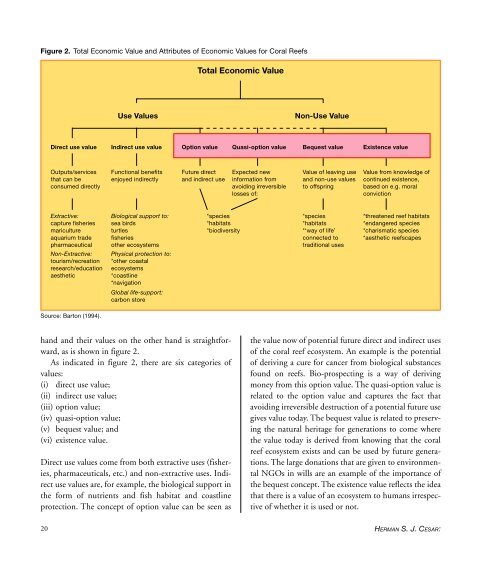You also want an ePaper? Increase the reach of your titles
YUMPU automatically turns print PDFs into web optimized ePapers that Google loves.
Figure 2. Total Economic Value and Attributes <strong>of</strong> Economic Values for <strong>Coral</strong> <strong>Reefs</strong><br />
Total Economic Value<br />
Use Values<br />
Non-Use Value<br />
Direct use value Indirect use value Option value Quasi-option value Bequest value Existence value<br />
Outputs/services Functional benefits Future direct Expected new Value <strong>of</strong> leaving use Value from knowledge <strong>of</strong><br />
that can be enjoyed indirectly and indirect use information from and non-use values continued existence,<br />
consumed directly avoiding irreversible to <strong>of</strong>fspring based on e.g. moral<br />
losses <strong>of</strong>:<br />
conviction<br />
Extractive: Biological support to: *species *species *threatened reef habitats<br />
capture fisheries sea birds *habitats *habitats *endangered species<br />
mariculture turtles *biodiversity *‘way <strong>of</strong> life’ *charismatic species<br />
aquarium trade fisheries connected to *aesthetic reefscapes<br />
pharmaceutical other ecosystems traditional uses<br />
Non-Extractive: Physical protection to:<br />
tourism/recreation *other coastal<br />
research/education ecosystems<br />
aesthetic<br />
*coastline<br />
*navigation<br />
Global life-support:<br />
carbon store<br />
Source: Barton (1994).<br />
hand and their values on the other hand is straightforward,<br />
as is shown in figure 2.<br />
As indicated in figure 2, there are six categories <strong>of</strong><br />
values:<br />
(i) direct use value;<br />
(ii) indirect use value;<br />
(iii) option value;<br />
(iv) quasi-option value;<br />
(v) bequest value; and<br />
(vi) existence value.<br />
Direct use values come from both extractive uses (fisheries,<br />
pharmaceuticals, etc.) and non-extractive uses. Indirect<br />
use values are, for example, the biological support in<br />
the form <strong>of</strong> nutrients and fish habitat and coastline<br />
protection. The concept <strong>of</strong> option value can be seen as<br />
the value now <strong>of</strong> potential future direct and indirect uses<br />
<strong>of</strong> the coral reef ecosystem. An example is the potential<br />
<strong>of</strong> deriving a cure for cancer from biological substances<br />
found on reefs. Bio-prospecting is a way <strong>of</strong> deriving<br />
money from this option value. The quasi-option value is<br />
related to the option value and captures the fact that<br />
avoiding irreversible destruction <strong>of</strong> a potential future use<br />
gives value today. The bequest value is related to preserving<br />
the natural heritage for generations to come where<br />
the value today is derived from knowing that the coral<br />
reef ecosystem exists and can be used by future generations.<br />
The large donations that are given to environmental<br />
NGOs in wills are an example <strong>of</strong> the importance <strong>of</strong><br />
the bequest concept. The existence value reflects the idea<br />
that there is a value <strong>of</strong> an ecosystem to humans irrespective<br />
<strong>of</strong> whether it is used or not.<br />
20<br />
HERMAN S. J. CESAR:


















